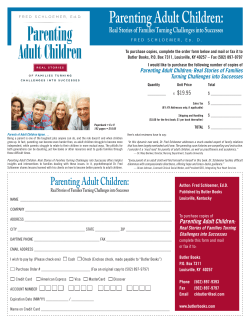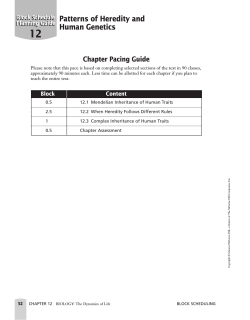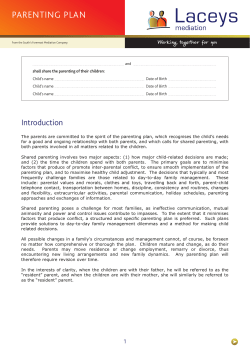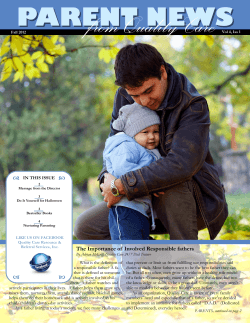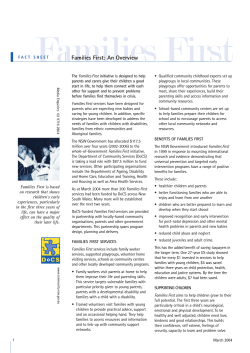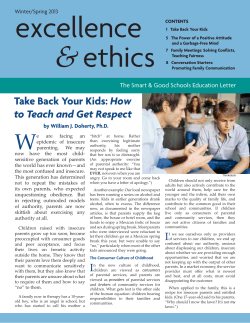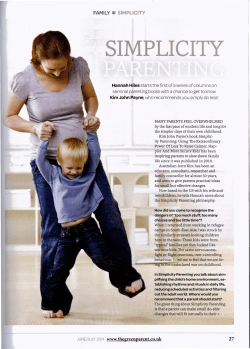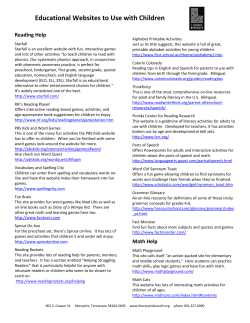
Document 242789
THE DEVELOPING CHILD Section 3-1: What Is Parenting? Teacher ~ Course Title ---'-'- _ TWE:Teacher'sWraparound Editi _ SW: Student Workbook OBJECTIVES The student will: • Explain how knowledge of child development is linked to reasonable expectations. • Distinguish among different parenting st}~. es. • Identify ways to improve parenting skills. • Describe how to nurture children. FOCUS o Motivator, TWE, page 82 o Vocabulary Activity, TWE, page 82 TEACH Teacher's Wraparound Edition o o o o Comprehension Check, TWE, pages 83-84 Activities, TWE, pages 83-86 Date(s) T W Th Class Period F _ TCR: Teacher's ClassroomResources CT: TransparencyPackage Student Workbook o Parenting and You, Activity, pages 31-32 Transparency Package o Positive Parenting Techniques, CT-8 ASSESS Review and Evaluation o o o o Section Review, TWE, page 87 Study Guide, Sw, pages 26-27 Section 3-1 Quiz, TCR, page 17 Testmaker Software Reteaching o o Reteaching Activity, TWE, page 87 Organizing Ideas About Parenting, Reteaching Activities, TCR, page 13 Enrichment, TWE, page 87 Extension, TWE, page 87 CLOSE o Copyright © Glencoe/McGraw-Hili I M Close Activity, TWE, page 87 THE DEVELOPING CHILD: Lesson Plan Organizers 13 · DATE NMlE CLASS PERIOD _ Reteaching Activity lVhat Is Parenting? Organizing Ideas About Parenting Directions. Complete the chart by answering the questions using information from Section 3-1. Give three reasons why parents need good judgment. 1. _ 2. _ 3. _ Name three parenting styles. 1. What are ways to learn about parenting? 1. _ 2. _ 3. _ _ What are the three main tasks of parenting? 2. 3. ~ 4. _ 1. _ _ 2. _ 3. _ _ THE DEVELOPING CHILD: Reteaching Activities Copyright © Glencoe/McGraw·Hill ----- 13 THE DEVELOPING CHILD Section 3-2: Guiding Children's Behavior Teacher _ Course Title _ Teacher'sWraparound Edition SW: Student Workbook TWE: Date(s) CI~sPeriod M T The student will: • Explain the importance of consistency in guiding children. • Apply effective techniques for encouraging appropriate behavior. • Explain how and why to set limits. • Identify effective ways of dealing with misbehavior. TCR: Teacher's ClassroomResources Cf: TransparencyPackage o Being Positive, Activity, pages 33-34 Teacher's Classroom Resources o Evaluating Guidance Techniques, Case Studies, pages 10-11 o Rewarding Good Behavior; Extending Learning, pages 9-10 Review and Evaluation o Motivator, TWE, page 88 o o Section Review, TWE, page 99 Vocabulary Activity, TWE, page 88 o Study Guide, Sw, pages 27-29 TEACH Teacher's Wraparound Edition Comprehension Check, TWE, pages 90-96 Activities, TWE, pages 89-98 o o o Enrichment, TWE, page 99 Section 3-2 Quiz, TCR, page 18 Testrnaker Software Reteaching o Reteaching Activity, TWE, page 99 Evaluating Ways of Guiding Children, Reteaching Activities, TCR, page 14 Extension, TWE, page 99 CLOSE o 14 THE DEVELOPING CHILD: Lesson Plan Organizers F _ ASSESS FOCUS o o Th Student Workbook OBJECTIVES o o W Close Activity, TWE, page 99 Copyright © Glencoe/McG,~ NAME DATE CLASS PERIOD _ :~~~ii;t~~..,~-<".C" Reteaching Activity .~",L_~;-;,:'~: Guiding Children's Behavior Evaluating Ways of Guiding Children Directions. Read the following descriptions of attempts to guide behavior. If you think the parent acted wisely, put a plus (+) in the space to the left of the description. If you think the parent did not act wisely, write a minus (-) in the answer space and then, in the spaces below the description, explain why and write what you would do. 1. Victoria told her two-year-old to put the toys away.When "thechild started to do so,Victoria said, "Stop! Don't put them there!" Then she walked out of the room. 2. Stephan told his son, "OK, Jamal, it's time for bed now. Which book do you want to read before bedtime? 3. When Maria finished brushing her teeth, her mother said, "That was good of you to brush your teeth right after the snack. It's no wonder that you had such a good checkup at the dentist last month." 4. As Mark drove his daughter home from the child care center, he finished his coffee and then threw the container out the window. S. Elijah was just pushing his vegetables around on his plate. His mother said, "Look, if you eat your broccoli, you can have some ice cream." 6. When Mandy described how she and her friends had made fun of the new student in the class, her father laughed at the names they had called the new girLThen he said, "You really should be more fair to her." 14 THE DEVELOPING CHILD: Reteaching Activities Copyright © Glencoe/McGraw·Hili CHAPTER 3 CHECKING COMPREHENSION Use the Summary and the Reviewing the Facts questions to help students go over the most important ideas in Chapter 3. Encourage students to ask ques- . tions and add details. ICHAPTER Answers to 31 REVE -~- .- "'1 ~ =-~-~~ ..•. & ~---~:...--- ~- Summa~ to' Parents must meet chil- to' Home-based care options provide comfortable surroundings but caregivers may not be trained. Centerbased care may have better facilities but may be inflexible in hours. (Section 3-3) dren's basic needs, nurture them, and guide their behavior. (Section 3-1) V Guidance includes encouraging appropriate behavior, setting limits, and dealing with inappropriate behavior. Parents should be consistent. (Section 3-2) V Parents and children should Reviewing the Fads visit a substitute care facility and ask questions before choosing it. (Section 3-3) 1. Having reasonable expecta- tions. Possible response: So parents can understand children's needs. 2. Possible response: May change styles as children grow. 3. Possible response: Taking a course; to get exposure to different strategies. 4. Giving child opportunities for encouragement and enrichment; showing love, support, and concern. 5. Children lose trust and confidence, become confused. 6. Possible response: Setting a good example is effective because children learn by imitation. 7. Understand the child's desires; set the limit and explain it; acknowledge the child's feelings; give alternatives. 8. Possible response: They recognize that all people make mistakes; to remind the child of the limit. 9. Parents work or want the children to have social opportunities. 10. Both take place in a home setting. Home care is in the child's own home and is more expensive. Family care may include other children. 9. Why do pen substitute C2 regular basis. (Section 3-3: 10. Compare he. to family chi (Section 3-3: Thinking Critically Reviewing the Facts I. What is the first step in effective parenting? Why? (Section 3-1) 2. Why do parents sometimes change the same parenting style they use? (Section 3-1) 3. What do you think is the best way of gaining parenting skills? Why? (Section 3-1) 4. What is nurturing? (Section 3-1) S. What problems are caused by inconsistent guidance? (Section 3-2) 6. Choose one technique for encouraging appropriate behavior and describe why it is an effective technique. (Section 3-2) 7. Why is giving alternatives an important part of setting limits? (Section 3-2) 114 I. Comparing. What do you think is damaging to a child, deprivation or parenting? Why? 2. Applying. Nadine told Justin, age, "Your room is messy. Take care of it: would you reword Nadine's directic 3. Ranking. Which do you think are, most important factors in evaluatm; child care center? Why? Taking Action I. Enriching Life. Give an examplec something parents on a tight budget do to provide enriching experiences child. (Management) 2. Modeling. Write a script showing v child will think if a caregiver tells hi: her to act one way but gives exampi. different ways of behaving. [Leadersl UNIT 1: Children, Parenting, and You 114 __ ~c_-.:. I 8. Why do 50= ents give a;' when a chii: does sometz wrong? (See 3-2) EVALUATION o (ross-Curricular Connections ,"""",,guageArts. Write a brochure ~bing a parenting class intended for ~-:ime parents. In the brochure, list the t:s that would be covered in the ' .. If a child care center costs $3.50 '2:~how much would it cost per week a child in the program for five ':;Zv sessions of four hours each? How l:ye full-day sessions of nine hours ; ••re rkplace Connections , ersonal Skills. Whenever twoo.dd Addie becomes frustrated, she .s to hit other children. As a child ceacher, how would you talk to her .E about this problem? mation Systems. Suppose you == providing family care for four chilVhat basic information would you -:0 keep on each child? How would :.~eepthese records? . '<Family and Community \Connections 2. Learning About Child Care. As a class, create a fact sheet with the basic information you think is important about a child care center. Use one of those sheets to gather information about a child care center in your area. Add your sheet to a class booklet called "Community Child Care Services." Technology Connections I. Internet. Use the Internet to find out more about Head Start, Montessori preschools, or Highscope preschools, What are the programs like? Who qualifies to enter each program? What role do parents play? Write a one-page summary of your findings. 2. Computers. Experts say that the amount of time spent watching television or playing with computer games should be limited for children in substitute care settings. Why do you think they make that recommendation? Do you agree? ating Resources. Visit a library or tore and make a list of all the maga~hat offer advice to parents. Choose cd read two or three articles. Report ~dass about how good you think the CHAPTER 3: Effective Parenting Skills 1. Use the reproducible Chapter 3 Test in the Teacher's Classroom Resources box, or construct your own test using the Testmaker software. 2. For an alternative assessment, assign the Chapter 3 activity in the Authentic Assessment booklet in the Teacher's Classroom Resources box. EXTENSION 1. Assign=students either of the two extension activities in the Extending the Text booklet in the Teacher's Classroom Resources box. 2. Have students create a crossword puzzle that gives clues to important concepts in the chapter. Have them trade puzzles with another student and then complete the puzzle. Have students plan a theme for a booth they could create fora Parenting Fair. Possible themes include parenting in general, child guidance, and substitute care . Students should make lists of what activities, guest speakers, demonstrations, and reading materials will be available at their booth. 115 115
© Copyright 2025


